Abstract
The influenza epidemic of 1978 was studied on a college campus, since a college is a type of "total institution" in which work, residence, and recreation are all concentrated in one organization with clearly delineated social boundaries and a unique social structure, A survey of a sample of 418 persons (378 students, 40 faculty members) revealed that more than 48 percent of the students contracted influenza and that the intersemester vacation was a social factor that may have aided in the disease's penetration of the institution's boundaries. The vacation exposed the students to the distase, and the resumption of classes allowed influenza to spread rapidly in the student population, which was concentrated within the boundaries of the educational institution. The faculty exhibited relative immunity to the disease compared with the students, having only a 5 percent attack rate. There were no significant differences in the incidence or duration of illness among the students by sex, year in school, residence area, floor of residence, fraternity or sorority membership, or participation in fraternity or sorority recruitment activities.
Full text
PDF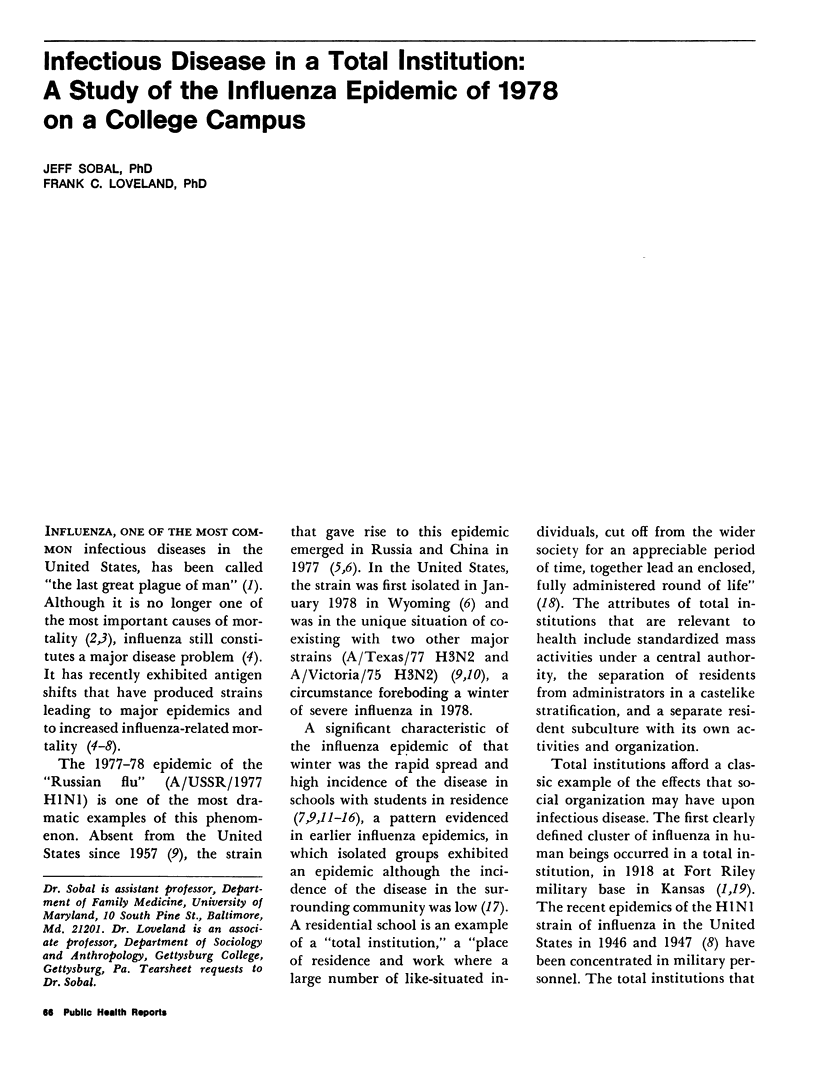
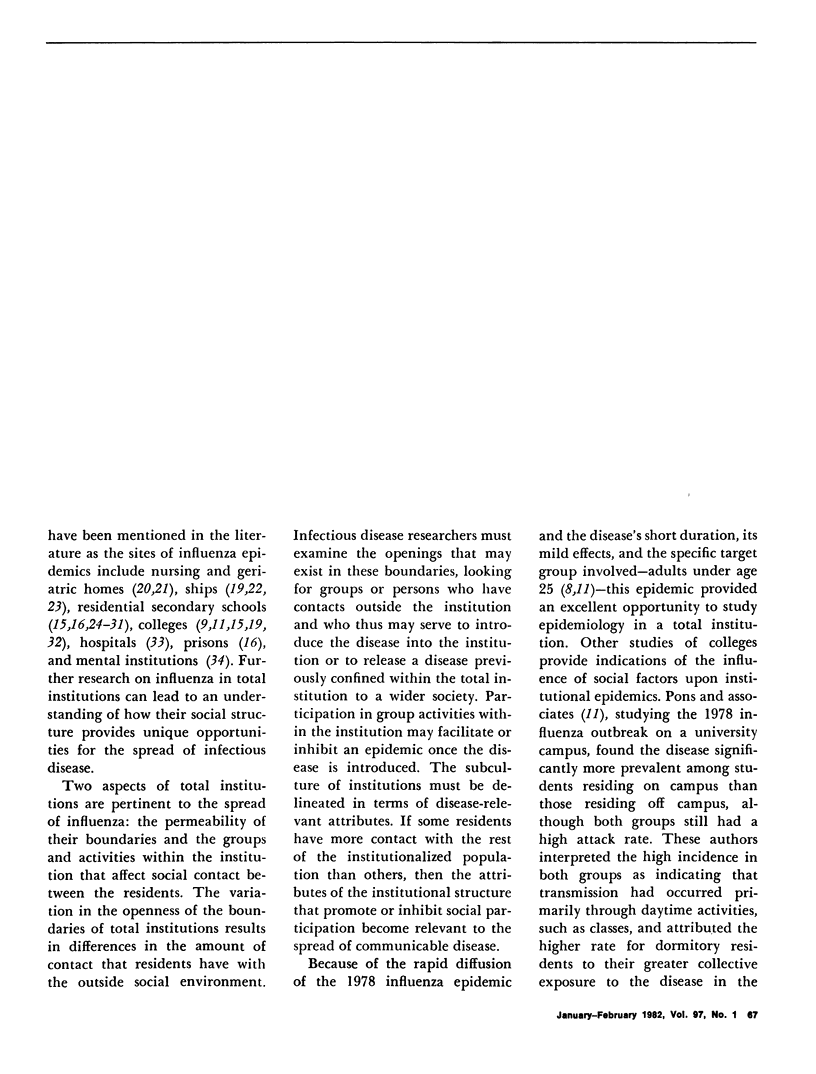
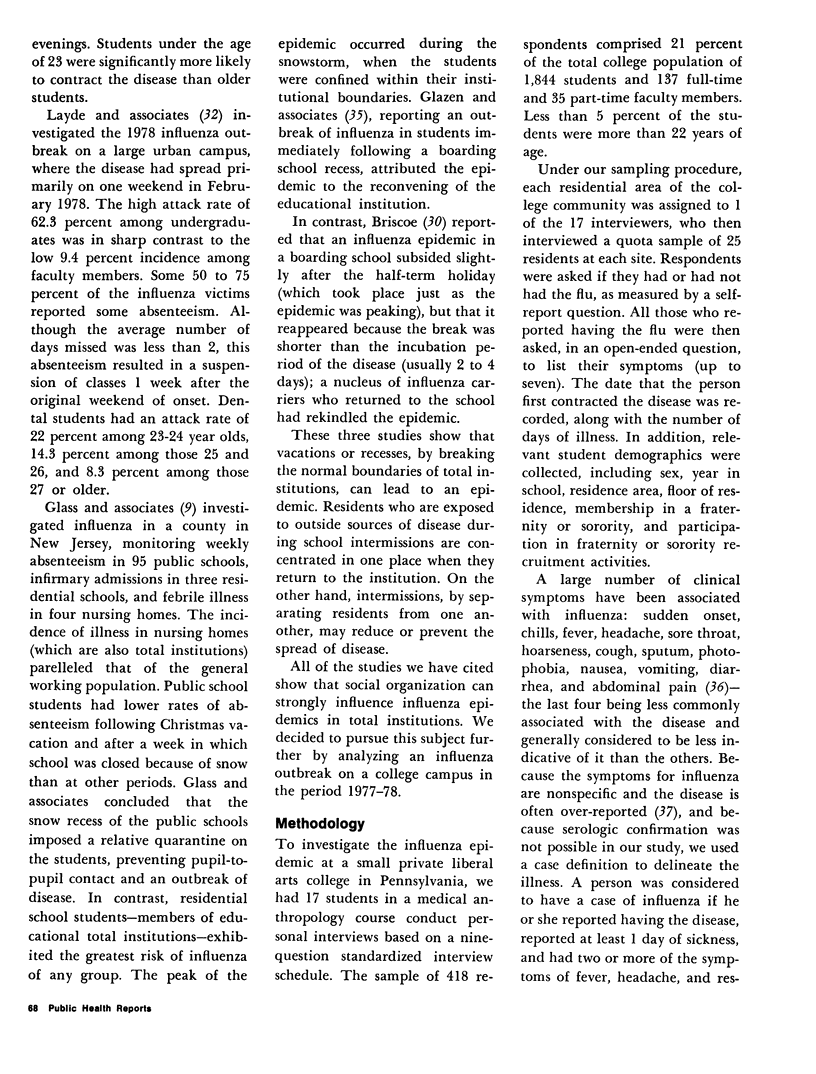
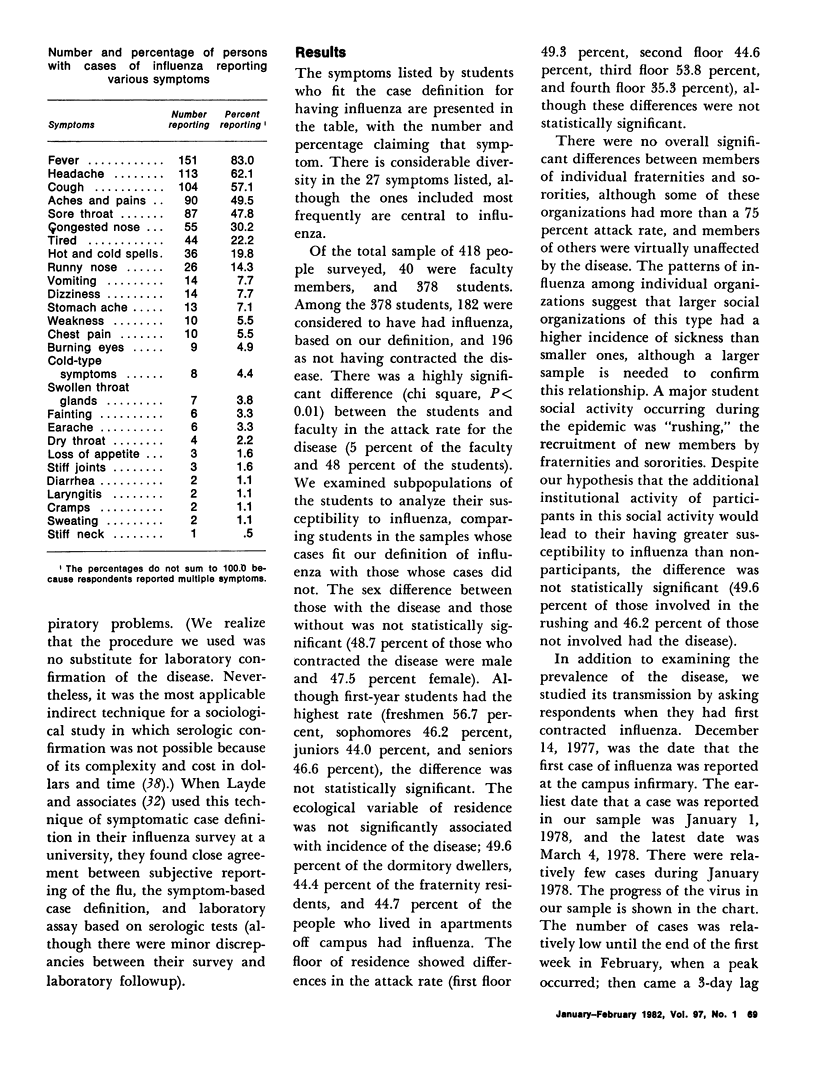
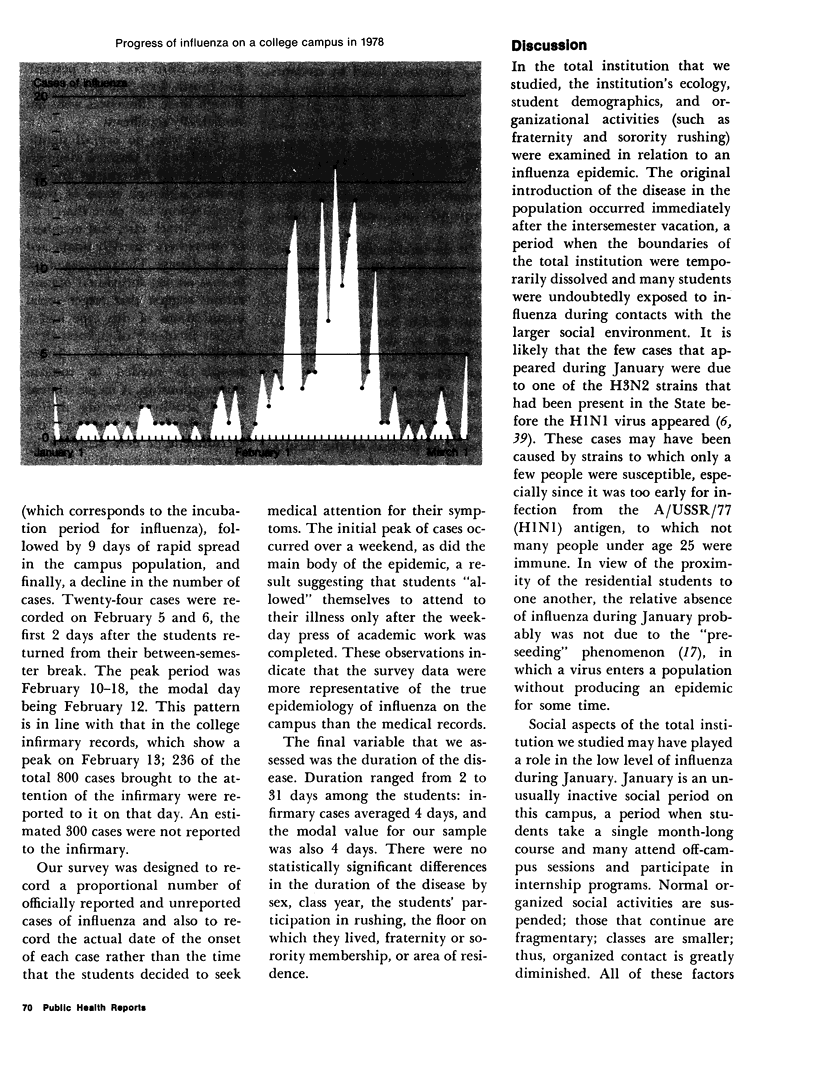
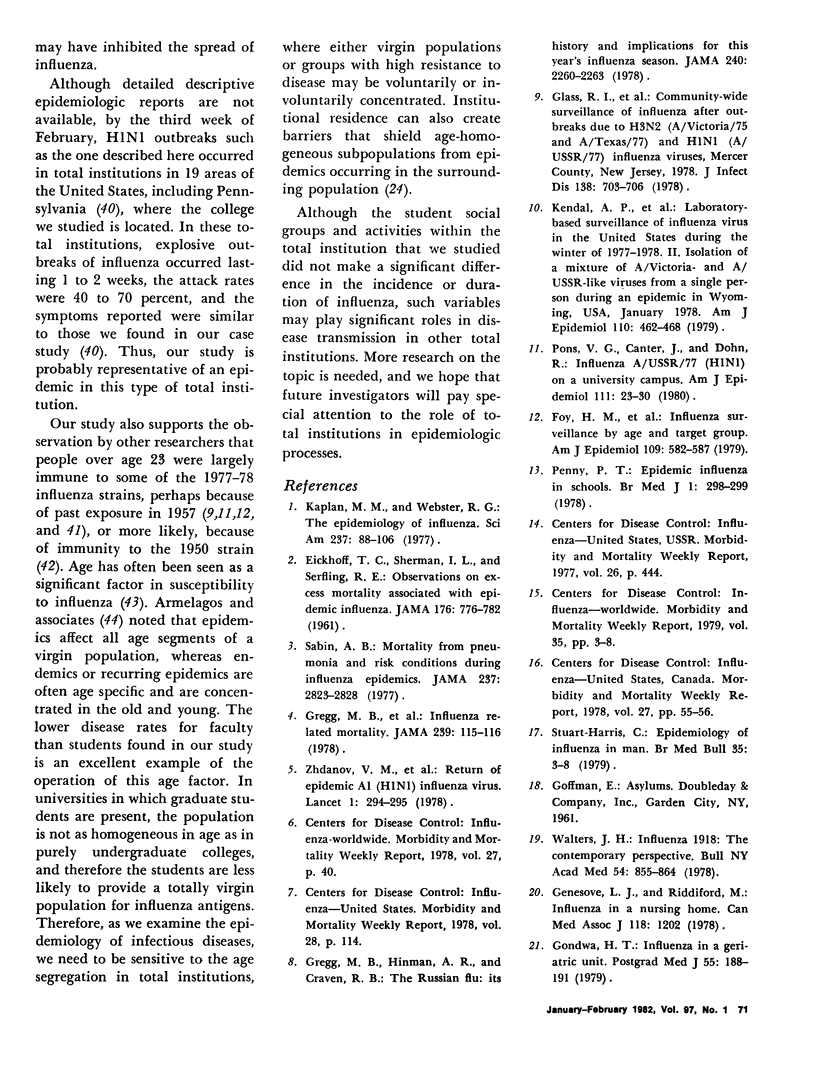
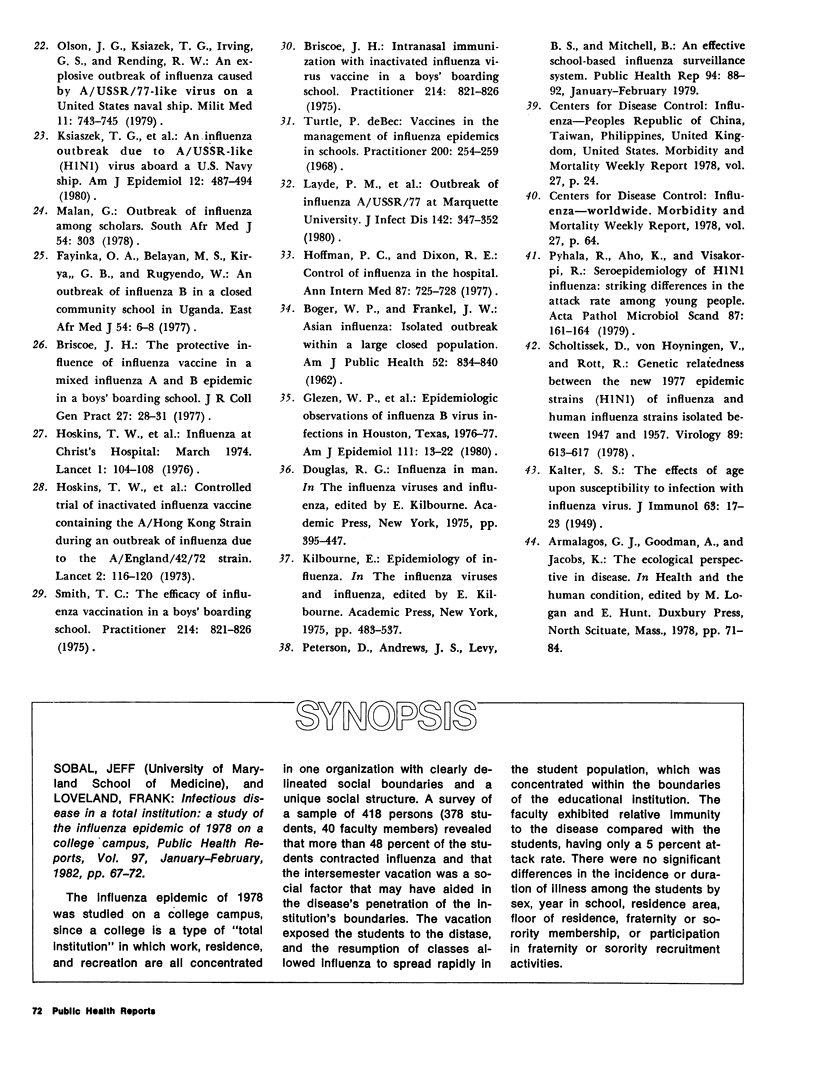
Selected References
These references are in PubMed. This may not be the complete list of references from this article.
- BOGER W. P., FRANKEL J. W. Asian influenza: isolated outbreak within a large closed population. Am J Public Health Nations Health. 1962 May;52:834–840. doi: 10.2105/ajph.52.5.834. [DOI] [PMC free article] [PubMed] [Google Scholar]
- Briscoe J. H. Intranasal immunization with inactivated influenza virus vaccine in a boys' boarding school. Practitioner. 1975 Jun;214(1284):821–826. [PubMed] [Google Scholar]
- Briscoe J. H. Intranasal immunization with inactivated influenza virus vaccine in a boys' boarding school. Practitioner. 1975 Jun;214(1284):821–826. [PubMed] [Google Scholar]
- Briscoe J. H. The protective effect of influenza vaccine in a mixed influenza A and B epidemic in a boys' boarding school. J R Coll Gen Pract. 1977 Jan;27(166):28–31. [PMC free article] [PubMed] [Google Scholar]
- EICKHOFF T. C., SHERMAN I. L., SERFLING R. E. Observations on excess mortality associated with epidemic influenza. JAMA. 1961 Jun 3;176:776–782. doi: 10.1001/jama.1961.03040220024005. [DOI] [PubMed] [Google Scholar]
- Fayinka O. A., Balayan M. S., Kirya G. B., Rugyendo W. An outbreak of influenza B in a closed community school in Uganda. East Afr Med J. 1977 Jan;54(1):6–8. [PubMed] [Google Scholar]
- Foy H. M., Hall C., Cooney M. K., Allan I., Fox J. P. Influenza surveillance by age and target group. Am J Epidemiol. 1979 May;109(5):582–587. doi: 10.1093/oxfordjournals.aje.a112716. [DOI] [PubMed] [Google Scholar]
- Genesove L. J., Riddiford M. Influenza in a nursing home. Can Med Assoc J. 1978 May 20;118(10):1202–1202. [PMC free article] [PubMed] [Google Scholar]
- Glass R. I., Brann E. A., Slade J. D., Jones W. E., Scally M. J., Craven R. B., Gregg M. G. Community-wide surveillance of influenza after outbreaks due to H3N2 (A/Victoria/75 and A/Texas/77) and H1N1 (A/USSR/77) influenza viruses, Mercer County, New Jersey, 1978. J Infect Dis. 1978 Nov;138(5):703–706. doi: 10.1093/infdis/138.5.703. [DOI] [PubMed] [Google Scholar]
- Glezen W. P., Couch R. B., Taber L. H., Paredes A., Allison J. E., Frank A. L., Aldridge C. Epidemiologic observations of influenza B virus infections in Houston, Texas, 1976-1977. Am J Epidemiol. 1980 Jan;111(1):13–22. doi: 10.1093/oxfordjournals.aje.a112865. [DOI] [PubMed] [Google Scholar]
- Gowda H. T. Influenza in a geriatric unit. Postgrad Med J. 1979 Mar;55(641):188–191. doi: 10.1136/pgmj.55.641.188. [DOI] [PMC free article] [PubMed] [Google Scholar]
- Gregg M. B., Bregman D. J., O'Brien R. J., Millar J. D. Influenza-related mortality. JAMA. 1978 Jan 9;239(2):115–116. [PubMed] [Google Scholar]
- Gregg M. B., Hinman A. R., Craven R. B. The Russian flu. Its history and implications for this year's influenza season. JAMA. 1978 Nov 17;240(21):2260–2263. doi: 10.1001/jama.240.21.2260. [DOI] [PubMed] [Google Scholar]
- Hoffman P. C., Dixon R. E. Control of influenza in the hospital. Ann Intern Med. 1977 Dec;87(6):725–728. doi: 10.7326/0003-4819-87-6-725. [DOI] [PubMed] [Google Scholar]
- Hoskins T. W., Davies J. R., Allchin A., Miller C. L., Pollock T. M. Controlled trial of inactivated influenza vaccine containing the a-Hong Kong strain during an outbreak of influenza due to the a-England-42-72 strain. Lancet. 1973 Jul 21;2(7821):116–120. doi: 10.1016/s0140-6736(73)93062-6. [DOI] [PubMed] [Google Scholar]
- Kaplan M. M., Webster R. G. The epidemiology of influenza. Sci Am. 1977 Dec;237(6):88–106. doi: 10.1038/scientificamerican1277-88. [DOI] [PubMed] [Google Scholar]
- Layde P. M., Engelberg A. L., Dobbs H. I., Curtis A. C., Craven R. B., Graitcer P. L., Sedmak G. V., Erickson J. D., Noble G. R. Outbreak of influenza A/USSR/77 at Marquette University. J Infect Dis. 1980 Sep;142(3):347–352. doi: 10.1093/infdis/142.3.347. [DOI] [PubMed] [Google Scholar]
- Malan G. Outbreak of influenza among scholars. S Afr Med J. 1978 Aug 19;54(8):303–303. [PubMed] [Google Scholar]
- Olson J. G., Ksiazek T. G., Irving G. S., Rendin R. W. An explosive outbreak of influenza caused by A/USSR/77-like virus on a United States naval ship. Mil Med. 1979 Nov;144(11):743–745. [PubMed] [Google Scholar]
- Penny P. T. Epidemic influenza in schools. Br Med J. 1978 Feb 4;1(6108):298–299. doi: 10.1136/bmj.1.6108.298-b. [DOI] [PMC free article] [PubMed] [Google Scholar]
- Peterson D., Andrews J. S., Jr, Levy B. S., Mitchell B. An effective school-based influenza surveillance system. Public Health Rep. 1979 Jan-Feb;94(1):88–92. [PMC free article] [PubMed] [Google Scholar]
- Pons V. G., Canter J., Dolin R. Influenza A/USSR/77 (H1N1) on a university campus. Am J Epidemiol. 1980 Jan;111(1):23–30. doi: 10.1093/oxfordjournals.aje.a112871. [DOI] [PubMed] [Google Scholar]
- Pyhälä R., Aho K., Visakorpi R. Seroepidemiology of H1N1 influenza: striking differences in the attack rate among young people. Acta Pathol Microbiol Scand B. 1979 Jun;87B(3):161–164. doi: 10.1111/j.1699-0463.1979.tb02420.x. [DOI] [PubMed] [Google Scholar]
- Sabin A. B. Mortality from pneumonia and risk conditions during influenza epidemics. High influenza morbidity during nonepidemic years. JAMA. 1977 Jun 27;237(26):2823–2828. [PubMed] [Google Scholar]
- Scholtissek C., von Hoyningen V., Rott R. Genetic relatedness between the new 1977 epidemic strains (H1N1) of influenza and human influenza strains isolated between 1947 and 1957 (H1N1). Virology. 1978 Sep;89(2):613–617. doi: 10.1016/0042-6822(78)90203-9. [DOI] [PubMed] [Google Scholar]
- Stuart-Harris C. Epidemiology of influenza in man. Br Med Bull. 1979 Jan;35(1):3–8. doi: 10.1093/oxfordjournals.bmb.a071538. [DOI] [PubMed] [Google Scholar]
- Turtle P. D. Vaccines in the management of influenza epidemics in schools. Practitioner. 1968 Feb;200(196):254–259. [PubMed] [Google Scholar]
- Walters J. H. Influenza 1918: the contemporary perspective. Bull N Y Acad Med. 1978 Oct;54(9):855–864. [PMC free article] [PubMed] [Google Scholar]
- Zhdanov V. M., Lvov D. K., Zakstelskaya L. Y., Yakhno M. A., Isachenko V. I., Braude N. A., Reznik V. I., Pysina T. V., Andreyev V. P., Podchernyaeva R. Y. Return of epidemic A1 (H1N1) influenza virus. Lancet. 1978 Feb 11;1(8059):294–295. doi: 10.1016/s0140-6736(78)90068-5. [DOI] [PubMed] [Google Scholar]


